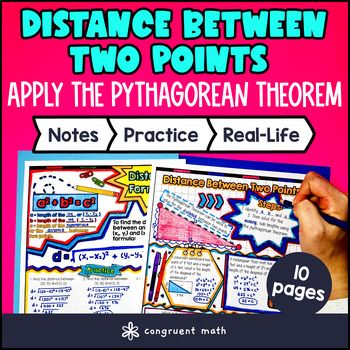Want more ideas and freebies?
Get my free resource library with digital & print activities—plus tips over email.
Join for Free Resources →
$4.25
Ever wondered how to teach the distance between two points in an engaging way to your eighth-grade students? In this lesson plan, students will learn about the distance formula by applying their knowledge of the Pythagorean Theorem. Through artistic, interactive guided notes, practice activities like a doodle and color by number, and a maze worksheet, students will gain a comprehensive understanding of the topic.
The lesson ends with a real-life example that explores how the distance between two points can be applied to real life situations.

$4.25
After this lesson, students will be able to:
Before this lesson, students should be familiar with:
As a hook, ask students why understanding the distance between two points is important in real-life scenarios. Refer to the last page of the guided notes as well as the FAQs below for ideas.
Use the first page of the guided notes to introduce the concept of finding the distance between two points using the Pythagorean Theorem. Students practice solving for the unknown distance (i.e. hypotenuse) when given the vertical and horizontal lengths (i.e legs). Review the definition of the Pythagorean Theorem and vocabulary terms such as legs and hypotenuse. Then, connect the Pythagorean Theorem to the distance formula.
Use the second page of the guided notes to formally introduce the distance formula. Students then practice finding the distance between two ordered pairs and two points on a coordinate plane.
Based on student responses during the introduction, reteach any concepts that students may need extra help with. If there is a wide range of proficiency levels in the class, consider pulling out students for reteaching while having more advanced students begin engaging with the practice exercises.
Have students practice finding missing distance by apply the distance formula using the maze activity (pg. 3) in the guided notes resource. Encourage students to work collaboratively and discuss their approach to solving the problems.
Fast finishers can engage with the color by number activity (pg. 4) for additional practice. This will reinforce their understanding of the theorem in a fun and creative way. You can assign the Maze activity as homework to consolidate their learning further.
Bring the class back together, and introduce the concept of applying the distance formula in real-world scenarios. Discuss how the distance formula is used in fields like GPS and satellites. Refer to the FAQ for more ideas on how to teach real-life applications of the distance formula.
If you’re looking for digital practice for Distance Between Two Points and Pythagorean Theorem, try my Pixel Art activities in Google Sheets. Every answer is automatically checked, and correct answers unlock parts of a mystery picture. It’s incredibly fun, and a powerful tool for differentiation.
Here’s 1 activity to explore:
A fun way to wrap this lesson with your students is with one of my real-life math projects. They enable students to see the application of the math in an engaging, extended project:
The Pythagorean Theorem can be used in various real-life scenarios, such as measuring distances, construction projects, navigation, and sports field design.
The Pythagorean Theorem states that in a right triangle, the square of the length of the hypotenuse is equal to the sum of the squares of the lengths of the other two sides.
In a right triangle, the two sides that form the right angle are called the legs, and the side opposite the right angle is called the hypotenuse.
Guided notes provide a structured framework for students to follow along during a lesson, helping them take organized notes, identify key concepts, and engage actively in the learning process.
The Pythagorean Theorem is a fundamental principle in geometry, serving as a building block for various geometric concepts and applications in fields such as engineering, architecture, physics, and computer graphics.
Get my free resource library with digital & print activities—plus tips over email.
Join for Free Resources →